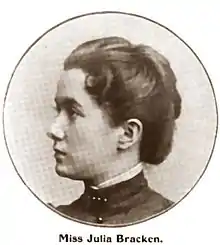Julia Bracken Wendt
Julia Bracken Wendt, (1870–1942) a notable American sculptor, was born on June 10, 1871 in Apple River, Illinois,[2] the twelfth of thirteen children in an Irish Catholic family.[3]
Julia Bracken Wendt | |
|---|---|
 From The Illustrated American, 1893 | |
| Born | Julia Bracken 1870 Apple River, Illinois |
| Died | 1942 Laguna Beach, California |
| Nationality | American |
| Education | Art Institute of Chicago |
| Known for | Sculpture |
Notable work | Illinois Welcoming the Nations (1893) and The Three Graces: History, Science and Art (1914)[1] |
| Spouse(s) | William Wendt (m. after 1906) |
| Awards | Gold medal for sculpture at the 1915 San Diego Exposition[1] |
Unsupported at home following the death of her mother when she was nine years old, she ran away from home at thirteen. By sixteen she was working as a domestic servant for a woman who recognized her talent and drive, and paid to enroll her in the Art Institute of Chicago. There she studied with Lorado Taft and by 1887 she had advanced to become his studio and teaching assistant.[4] In 1893, during the Columbian Exposition she was one of several women sculptors nicknamed the White Rabbits who helped produce some of the architectural sculpture that graced the exposition buildings.
Aside from that she was awarded a commission to produce Illinois Welcoming the Nations for the Fair. The work was later cast in bronze and unveiled at the Illinois State Capitol,[5] at which time Governor Altgeld was the main speaker.
After successfully pursuing her career for a number of years, in 1906 she married painter William Wendt and moved to Los Angeles, California where she continued her success.[3] In California she taught at the Otis Art Institute[6] and, with her husband, was instrumental in the founding of the California Art Club in 1909, which was developed on the premise of allowing women and sculptors into the membership.[7]
Wendt was a member of the National Sculpture Society and exhibited and was featured in both the 1923 and 1929 Exhibitions and the resulting catalogues.[8][6]
She died in Laguna Beach on June 22 1942. [2]
Work
Her work can be found in:
- Chicago Historical Society
- Civil War Monument, Missionary Ridge, Chattanooga, Tennessee
- Laguna Art Museum
- Harvard University Portrait Collection
- old Los Angeles City Hall (now located in the Natural History Museum of Los Angeles County)
- Lincoln Park, Los Angeles, California
- as well as in numerous private collections
References
- "Wendt, Julia Bracken (1871–1942)". Women in World History: A Biographical Encyclopedia. Encyclopedia.com. Retrieved 21 May 2017.
- Hughes, Dean Milton (1986). Artists in California, 1786-1940 (1st ed.). Hughes Pub. Co. p. 496. ISBN 0961611200.
- Rubenstein, Charlotte Streifer, ‘’American Women Sculptors: A History of Women Working in Three Dimensions’’, G. K. Hall and Co. Boston, 1990 pp. 105*110
- McKay, James, The Dictionary of Sculptors in Bronze, Antique Collectors Club, London, 1995
- Taft, Lorado, ‘’The History of American Sculpture’’, The Macmillan Company, New York, 1925 p. 528
- National Sculpture Society, ‘’Contemporary American Sculpture’’, National Sculpture Society, NY 1929
- See Julia Bracken Wendt's response (Open Letter, Los Angeles Times, January 1910) to Antony Anderson's Art and Artists column from December 12, 1909.
- National Sculpture Society, ‘’Exhibition of American Sculpture Catalogue’’, National Sculpture Society, NY 1923
External links
| Wikimedia Commons has media related to Julia Bracken Wendt. |
- Works by or about Julia Bracken Wendt at Internet Archive
- Image of sculptor Julia Bracken Wendt and Mayor Frank Shaw next to a newly dedicated fountain that includes her work, Los Angeles, California, 1933. Los Angeles Times Photographic Archive (Collection 1429). UCLA Library Special Collections, Charles E. Young Research Library, University of California, Los Angeles.